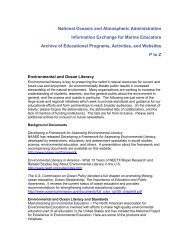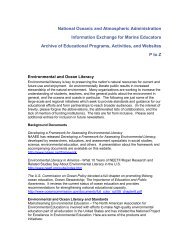Information Exchange for Marine Educators - Archive of Programs P-Z
Information Exchange for Marine Educators - Archive of Programs P-Z
Information Exchange for Marine Educators - Archive of Programs P-Z
Create successful ePaper yourself
Turn your PDF publications into a flip-book with our unique Google optimized e-Paper software.
Regional <strong>In<strong>for</strong>mation</strong> Centers on MPA Planning Processes<br />
The National <strong>Marine</strong> Protected Areas Center launched a series <strong>of</strong> web-based regional<br />
in<strong>for</strong>mation centers designed to provide comprehensive in<strong>for</strong>mation on ongoing federal,<br />
state, and tribal MPA planning processes. Stakeholders can search the in<strong>for</strong>mation<br />
centers by region <strong>of</strong> the US or by state. While the in<strong>for</strong>mation centers are a work in<br />
progress and not all regions are completely populated, the Pacific Coast and New<br />
England regions are either complete or include a significant amount <strong>of</strong> in<strong>for</strong>mation.<br />
http://www3.mpa.gov/mpa_calendar/query/searchbyregion.aspx<br />
The Regional Ocean Conservation Club<br />
The purpose <strong>of</strong> the Regional Ocean Conservation Club (ROCC) is to develop a student<br />
coalition where students are encouraged to take an interest and become involved in<br />
local marine and aquatic issues facing the environment. The mission is to have high<br />
school students work with local, state and national organizations to protect and restore<br />
the health <strong>of</strong> marine and aquatic resources through education and conservation<br />
programs.<br />
http://www.igfa.org/ROCC.asp .<br />
Remote Sensing and Coral Reefs<br />
NOAA’s Coral Reef Watch <strong>of</strong>fers Remote Sensing and Coral Reefs, a free,<br />
downloadable curriculum unit <strong>for</strong> 4 th – 6 th grade students on remote sensing and its<br />
application to monitoring coral reefs. This set <strong>of</strong> 7 lesson plans is also appropriate <strong>for</strong><br />
many middle school classrooms, and many <strong>of</strong> the lessons can stand alone as individual<br />
classroom activities. Topics include Remote Sensing and the Electromagnetic<br />
Spectrum, Introduction to Coral Reefs, Coral Reef Conservation, and much more.<br />
http://coralreefwatch.noaa.gov/satellite/education/reef_remote_sensing.html<br />
Remote Sensing Lesson Plans from IMaRS<br />
The Institute <strong>for</strong> <strong>Marine</strong> Remote Sensing (IMaRS) provides education outreach through<br />
a number <strong>of</strong> venues. IMaRS has presented teacher workshops, with hands-on tools <strong>for</strong><br />
the manipulation <strong>of</strong> satellite data as well as background in<strong>for</strong>mation necessary to provide<br />
the correct in<strong>for</strong>mation to their students. On-line lesson plans and background<br />
in<strong>for</strong>mation are available on their website. The lesson plans include both broad marine<br />
science concepts as well as specific remote sensing lab work.<br />
http://education.imars.usf.edu/index.html<br />
Remote Sensing Toolkit<br />
The aim <strong>of</strong> the online remote sensing toolkit is to show managers, scientists, and<br />
technicians working in marine, terrestrial, and atmospheric environments how images<br />
collected from satellites and aircraft can be used to map and monitor environmental<br />
features or processes and their change over time. Users can select to view graphics or<br />
read the text. The resources section <strong>of</strong>fers a quick list <strong>of</strong> manuals and data sources.<br />
http://ww2.gpem.uq.edu.au/CRSSIS/tools/rstoolkit_new/index.html<br />
Repeat Glacier Photography at Kenai Fjords<br />
Kenai Fjords National Park, located on the eastern edge <strong>of</strong> Alaska’s Kenai Peninsula, is<br />
home to the largest concentration <strong>of</strong> tidewater glaciers in the U.S. National Park System.<br />
Changes in these glaciers have never been more obvious nor easy to comprehend,<br />
thanks to a cooperative project between the National Park Service and the U.S.<br />
Geological Survey.<br />
http://www.oceanalaska.org/research/rptglacier-video.htm






